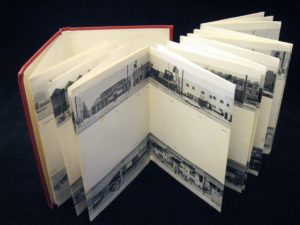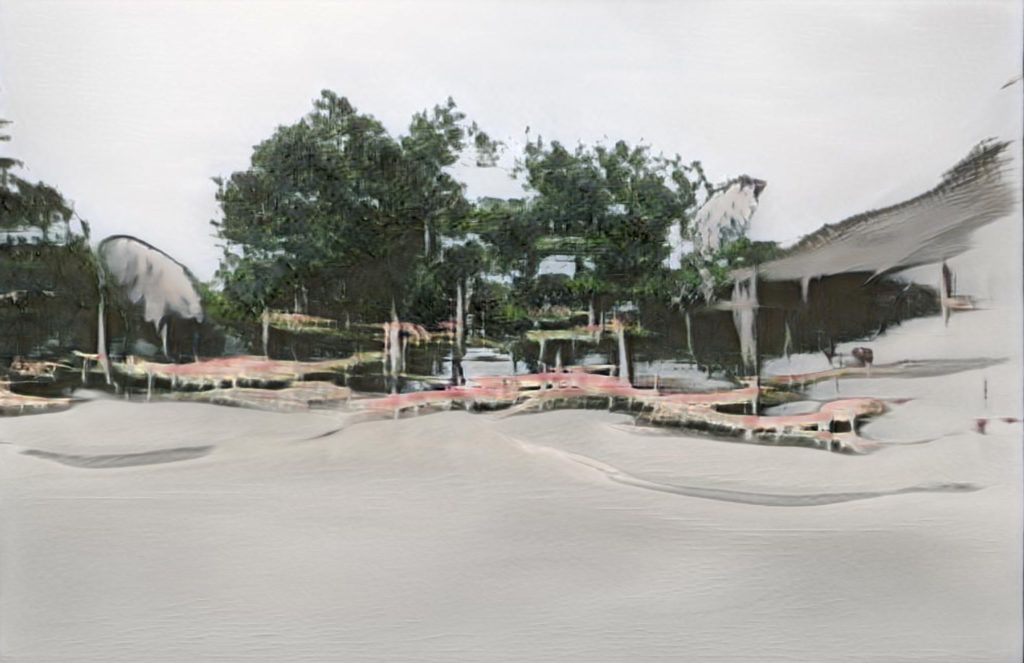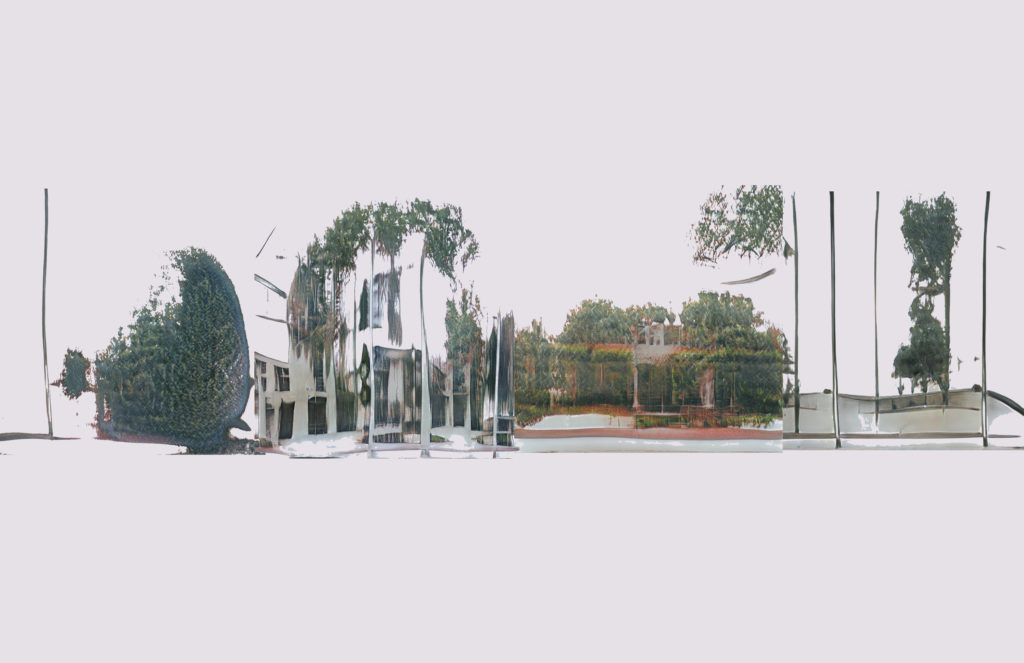In 1965, Ed Ruscha stood on the bed of a moving pickup truck and photographed Sunset Boulevard. Through this process he calls “motorized photography,” he captured the entirety of a mile-and-a-half long segment of the street with mechanized precision. These images were then collaged for Every Building on the Sunset Strip (1966), a book whose accordion-folded pages unfurl over 27 feet. The experience was not a one-off. Ruscha would soon traverse different thoroughfares in Los Angeles, including Wilshire and Sepulveda Boulevards, and perform the same operation. Every few years, he—and now others in place of the 83-year-old pop artist—returned to these streets to photograph them again and again. The cumulative result of the ongoing endeavor, which could be classified as a long-duration artwork as much as data collection, is an archive of over one million images. The Getty Institute recently acquired this unique history of Los Angeles’s built environment in pictorial form and, to date, has digitized over 60,000 photographs. Their goal is to make it both accessible to the public and, as Charles Waldheim’s spring studio, “Shading Sunset: Reimagining the Streets of Los Angeles for a Warmer Future,” exemplifies, useful as a tool for imagining alternative futures of the city.

Ruscha’s deadpan documentation of American vernacular design did not begin in 1965. Two years prior, he published his first book, Twentysix Gasoline Stations, which features black-and-white photographs of monuments located between his native Oklahoma and Los Angeles. Form and function fascinated him. “I would look at a building and disregard the purpose of that building (in this case a commercial outlet to sell gasoline). I was really more interested in this crazy little design that was repeated by all the gas companies to make stations with an overhang to create shade for their customers,” Ruscha has said. “It seemed to me a very beautiful statement.” Gas stations would appear in his paintings at the time, too.
In the 1960s, this respect for the quotidian was echoed by many non-American architects, urbanists, and theorists. Denise Scott Brown and Reyner Banham were among those who came to the United States in part because its cities were viewed from elsewhere as illegitimate, lacking good taste, and even degenerate. “They were looking for evidence of the contemporary city,” says Waldheim. “In Ruscha’s work, especially the Streets of Los Angeles project, they find a kind of Duchampian readymade. It’s not only a city and the documentation of that city but a way of seeing which confounds architectural criticism. Without judgment, Ruscha documented everything. In that, there’s a kind of empathy as well as a kind of empiricism.”
Scott Brown and Robert Venturi visited Ruscha’s studio with their Yale students, who were directed to apply Ruscha’s nonjudgmental, indexical aesthetic to their work on Las Vegas. This work led to the duo’s seminal 1972 study, Learning from Las Vegas. And Reyner Banham Loves Los Angeles (1973), a BBC documentary shot in the manner of a European travelogue which takes a cheeky but almost reverent look at Los Angeles, even guest stars Ruscha.
The initial motorized photography ventures inspired these figures. Now no one, not even Ruscha, can reasonably view every image in the series. The Getty had to double its server size upon acquiring them. To Waldheim, this archive represents a form of big data avant la lettre. Compared to traffic surveillance footage or social media posts, however, these images are less clouded by concerns regarding big data’s problematic biases, which allows for more freedom in utilizing them as research material.

The Getty convened a group of art and architectural historians to analyze the archive. “Among the challenges of interpretation associated with the archive is the impulse toward making these images sensible to traditional modes of human cognition—the notion that if I can see it, I can understand it. That leads to making them searchable by address, building type, etc.,” Waldheim explains. But the sheer number of images recommends, if not requires, novel technology and methods, he argues. “Unlike cartography or public health, for example, design is by definition speculative. Big data sets like this give us an opening to a way of working that can be described as machine- and rule-based. They allow us to put less pressure and cognition on our own biases and produce an environment in which nonlinear and unexpected outcomes are generated. It’s outside the immediate what/where of the architect’s faculty cognition. That’s an enormous advantage because it allows us to get past preconceptions and organize other forms of information to inform design decisions.”
To this end, Waldheim proposed a form of Style Generative Adversarial Network, or StyleGAN, modeling as the studio’s foundational tool. This workflow for the studio was developed by Waldheim, Aziz Barbar, and Min Yeo from the GSD’s Office for Urbanization in collaboration with a team led by Jose Luis García del Castillo López and the GSD Laboratory for Design Technologies. A form of machine learning built on facial recognition, the technology entails feeding images with a particular pattern into a system, training it to comprehend this pattern, and then feeding it a different set of images featuring a new pattern so it can learn difference. By processing thousands of Ruscha’s photographs, for example, the machine recognizes the precise visual composition of certain neighborhoods, structures of space, and building typologies—a task that exceeds human cognition. After doing so, it generates strikingly real images, similar to deepfakes, that are uncanny fictions. “I think of it as akin to alternative fiction in a literary sense,” says Waldheim. “It also has similarities to distanced or delayed authorship in the historical avant-garde, in which artists produced and generated forms that were not under their control.”
Waldheim considers using technology in this way as an iteration of da Vinci’s advice to stare at clouds or stains on walls for inspiration. This comparison becomes explicit in Los Angeles–based artist Refik Anadol’s animations, such as those he created of Stockholm harbor or New York City architecture. Called “machine hallucinations” by Anadol, these animations begin by feeding a StyleGAN sometimes over 100 million images of a specific place from many different time periods. From this input, he creates a slowly morphing video of that particular area, as if reflected in a rippling pool of water. At first, all seems recognizable and accurate; upon further inspection, it’s evident that the buildings featured do not exist in reality. Rather, they are various iterations or manipulations of what is technically referred to as the “latent space” (forms, lines, proportionality) of the images fed into the network. What we see, in Waldheim’s reading, are “parallel worlds that could have happened based on these rules but didn’t.”

While a design process that utilizes StyleGAN does not eliminate the designer’s subjectivity from the process—the images the system receives must be curated—it undercuts a normative sense of authorial agency. “Instead of starting with a blank page, a declaration that ‘I will do this,’ questions of taste or culture, and a virtuosic exhibition of drawing, this places more emphasis on the designer’s reflective and interpretive qualities,” Waldheim explains. “I find it incredibly productive for architects to produce imagined realities. It doesn’t mean those realities are good things or that we should realize them in the real world, but it calls on different faculties of the designer to make judgments about them. It triangulates the curatorial agenda, the making of images of alternative futures, and the architect’s interpretation of those images.”
The process simultaneously supports and rejects the traditional association of technology with efficiency. StyleGAN’s automation accelerates the process of coding and analyzing an archive that exceeds human capacities, but only as a tool to give the designer time and freedom to engage in other tasks. “It changes the relationship between the architect and the object of their study,” says Waldheim. “We’ve gone from a paradigm of representation to a paradigm of automation of the imagination on behalf of the designer. The architect used to be pictured with their drawings, and that’s falling away to workflows and processing. Early digital drawings were themselves simulacra for things we used to do. This way of working, with technology like StyleGAN modeling, is a different form of representation that multiplies the faculties of the designer and changes their labor. We have to become data scientists, in a way, and focus much more on judgment, advocacy, and curation around what these images portend or afford.”
For the studio, this curation requires identifying certain themes in Ruscha’s images that need urgent attention, among them homelessness and disparities of environmental justice related to race and ethnicity. These issues are among the many examined in the Future of the American City project, an urban-study initiative at the GSD funded by the John S. and James L. Knight Foundation, which spotlights Miami, Detroit, and Los Angeles.
One theme that unites many of these concerns has become increasingly important in recent years: shade. In Los Angeles specifically, shade has become a scarce resource, with the city’s iconic palm trees providing little cover from increased heat-island effects. A public health concern that results from global warming and is exacerbated by public policies and design ideologies, this lack affects the most vulnerable populations who have limited access to the tree canopy. Mayor Eric Garcetti acknowledged a need for intervention and, in October 2019, began a Cool Streets project that includes planting 90,000 by the end of this year, building covered bus-stop benches, and installing cool pavement.
“The unconditional positive regard for more and more sunlight is deeply steeped in the way architects and urbanists have been trained in the West for at least a century,” says Waldheim. “The oldest regulations about what you could build in the Anglo tradition—the English ‘right to light’ laws and the origin of city planning in New York—all come back to the fundamental issue of not wanting to die in the shadow of someone’s enormous building constructed for profit.” This ideology perhaps has reached its terminus, as greater concern is placed on low-carbon energy construction and structures that provide shade. The backlash against police surveillance cameras, which require unobstructed sight lines and connect darkness with criminality, also critiques this ethos of total visibility.
Ruscha’s archive, an unintended precursor to Google Street View with similarities to surveillance footage, metaphorically exemplifies this long-term obsession with pure knowledge and illumination. But as a tool for imagining a more shade-filled future, it can be read negatively—by identifying what it doesn’t represent or what its focus makes invisible.
The images’ pure horizontality implies an equalization across class, race, and ethnic groups. Close examination, however, reveals the distinct shifts between municipal boundaries and the extent to which disparities like decreasing percentage of tree canopy have been exacerbated over multiple decades. The images provide substantial evidence for where plant material once was, its height, how much shade it produced, and how it changed over time. Seeing this evolution provides evidence for where vegetation might be increased, with StyleGAN modeling employed as a tool to give a realistic glimpse of how that could appear.
Even more fundamental is the absence of people in the photographs, which goes unnoticed in part due to the viewpoint from a car that diminishes the presence of the sidewalk. This establishes the automobile, not the human body, as the primary actor in public space, which suggests speed and movement’s supremacy over stasis. Not every Angeleno owns a car though, and regardless, every person deserves space on the sidewalk to exist without enduring intense sunlight and its resulting stresses. COVID-19 has made explicit that most humans long for contact and time in public. But the built environment in American cities is increasingly hostile to occupation, as anti-homeless technology like dividers on benches and a lack of covered seating generally demonstrate. The Ruscha archive may show where generous, equitable spaces once were and what happened to them over time, in addition to revealing the panoply of spaces most people avoid.
“The goal of the studio might be to reconceive the street fundamentally by returning to the Ruschaian vocabulary in a perverse way to examine what it affords, who it accommodates, who it surveils, how much sun there is, and who is authorized to be there,” says Waldheim. “Without being stylistic, regional, or contextual, we’re asking if there is something to draw from Ruscha that is Angeleno in its ‘essence.’ I believe there is, for example, an infinite number of latent Ruscha Sunset Boulevards. If we develop the latent spaces available within Ruscha’s archive which address issues like shade and shelter, that can inform what we project forward when imagining an alternative to the current conditions on the streets of the city.”
